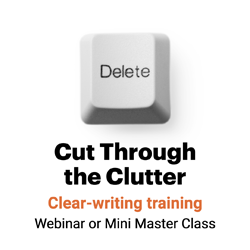5 steps to simplifying your message
How can you clarify your message?

The authors of “Complex to Clear: Managing Clarity in Corporate Communication” developed this CLEAR mnemonic for simplifying your subject:
1. Contextualized
The authors say: Provide the context or background of a message upfront. Who should read this and why? When and how should it be used?
Ann says: That might work for a business memo or email, but putting the blah-blah background first is hardly a compelling way to start a press release, blog post or other business story. Instead, use a feature-style story structure to:
- Catch the readers’ attention with a compelling illustration (see “Resonating”) in the lead.
- Tell ’em what you’re going to tell ’em in the nut graph.
- Provide context in the background section.
One problem with inverted pyramids is that the context and background fall to the bottom of the pyramid. As a result, “only journalists and sources can fully understand inverted-pyramid stories,” write the authors of “Ways with Words,” a study by the American Society of Newspaper Editors and The Poynter Institute.
Here are three more ways to provide context early in your piece:
- Call out to the intended reader in the headline by starting with the reader — “Asthma sufferers …,” “New mothers …” or “Business communicators …,” for example.
- Add a standard label to the beginning of your subject line — “Action required,” “Response requested,” or “Deadline: 3/15,” for instance.
- Summarize the context in the deck.
2. Logically structured
The authors say: A logical structure is needed in order to have a scaffold or support with which to process and interpret new information. Structure the message in a logical and accessible manner. What is the overall logic of the message? How do the elements build on each other?
Three structures that might work for your memos and articles:
- SPIN: situation, problem, implications, next steps
- Pioneer Hi-Bred’s corporate communication memo structure, developed by Mike Hall: situation, response strategy, media coverage, media strategy, standby statement to press
- Narrative story structure: the hero’s context, the obstacle to overcome, a failed attempt, a successful attempt (climax) a resolution and a moral, or lessons learned.
Ann says: Absolutely. In addition to the feature-style story structure, a story template can make a great foundation for your piece.
3. Essential
The authors say: The cognitive load theory argues that removing irrelevant or redundant information helps communicators avoid overloading readers’ working memory.
So focus on essential elements and show them in overview before going into details. What is the most important part? What can be left out? How can it be said more simply? Too much information (information overload syndrome) can lead to mental shortcuts and confusion.
Ann says: Several things going on here:
- Find your focus. Write a walk-away sentence summarizing what you want your reader to walk away with after reading your piece.
- Leave out the rest. Remove every paragraph, sentence and word that doesn’t help you make that point. Because the more we tell people, the less they understand.
- Cut Through the Clutter. Make paragraphs, sentences, phrases and words as simple and easy to understand as possible.
As for giving audience members an overview before going into details, that works better for speeches than copy. In a written piece, use subheads and other display copy to show readers the parts.
4. Ambiguity-free
The authors say: Remove vague terms or sentences and use terms with clear, specific meanings. Could any part of the message be misunderstood? Can the message be made more specific?
Ann says: Agreed. Jargon, passive voice, noun phrases and hyperbole slow stories down and muddy messages.
I especially appreciate the authors’ suggestion to provide a short glossary of key terms in the appendix.
5. Resonating
The authors say: Use a style and format that resonates with the audience and stimulates it to engage with the content. Does the communication address the receivers directly? Are there stimulating examples, questions, illustrations, etc.?
Offer illustrative examples and visualizations, as well as stories; and use appropriate analogies or metaphors. Don’t make your message dull.
Ann says: Who could disagree with that? Surprise and delight your readers with:
Graphic stories and other creative story formats also help engage readers.
____
Source: Martin J. Eppler, Ph.D., and Nichole Bischof, “Complex to Clear: Managing Clarity in Corporate Communication,” University of St. Gallen, November 2011

Leave a Reply